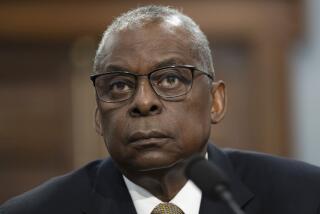Bush Ends Trip With a Symbolic Visit to Pearl Harbor
- Share via
HONOLULU — President Bush put a coda on his grand Asia-Pacific tour Thursday, stopping in Hawaii to pay a reverent visit to Pearl Harbor on a trip designed to make his war on terrorism a top priority in the region.
The president and First Lady Laura Bush tossed flowers over the wreck of the battleship Arizona and stood somberly as sailors piped taps over the water in a visit redolent with symbolism for the man who led the country through the aftermath of the Sept. 11, 2001, attacks.
“It’s first and foremost to pay tribute to those who fell many years ago. But there’s also an obvious historical parallel,” said White House Communications Director Dan Bartlett.
Bush and his advisors appeared pleased with results of their odyssey, in which the president squeezed six countries into seven days -- starting in Japan and following with the Philippines, Thailand, Singapore, Indonesia and Australia. He also managed two days at the Asia-Pacific Economic Cooperation summit in Bangkok, where he spoke with the leaders of such crucial allies as Russia, China and Mexico.
In an interview en route to Australia, the last foreign stop of the tour, Bush said one of his central successes was promoting “the clear understanding ... of the need to fight terror.”
“I’ve always felt that there’s a tendency for people to kind of seek a comfort zone and hope that the war on terror is over,” Bush said. “And I view it as a responsibility of the United States to remind people of our mutual obligations to deal with the terrorists.”
In his mind and to some of his allies, that includes intervening in Iraq. But more so than at home, Bush was forced during the trip to confront those who hold a different view, from protesters in Manila to Muslim clerics in Indonesia to Australian parliament members who heckled him during a speech.
None appeared to ruffle his confident demeanor. “I love free speech,” he told Australian lawmakers.
The encounters did not appear to have altered his views.
“My job is to do what I think is the right thing and lead,” Bush told reporters aboard Air Force One.
Bush aides say that what gives the president stature as a statesman is precisely that he speaks with a consistent voice.
“I think those world leaders appreciate that,” Bush explained. “There is a common bond that’s established when you’re in the decision-making process and you’re not trying to chase popular will, which is fickle and moves around. You stay focused on the objectives you set for a country.” But what Bush sees as leadership and consistency, others see as stubbornness.
“U.S. Might Does Not Make U.S. Right,” read one sign that was waved at Bush’s motorcade as he departed Australia, one of the United States’ staunchest allies. Other protesters who gathered along roads made rude gestures toward the motorcade.
Bush heads home to Washington with a string of what the White House considers diplomatic successes: a compromise proposal for North Korea, military and financial contributions for Iraq from Japan and Singapore and a new emphasis on security issues by APEC, a group designed primarily to address trade. The only thing on Bush’s list that he didn’t achieve, Bartlett said, was an agreement with Japan and China to ease currency controls that he feels puts U.S. exports at a disadvantage. Still, Bartlett added, Bush “views this as an issue that is not going to be solved overnight.”
All the countries on Bush’s itinerary were somehow connected to the war on terrorism. Two, the Philippines and Indonesia, got only short, hours-long visits. Both are dealing with terrorist groups on their territory, including some affiliated with Al Qaeda, and U.S. officials considered the nations too dangerous for Bush to spend the night. The president insisted on going, though, in part to appear fearless confronting those terrorists. However, the tight security in Manila and his confinement to the grounds of the Bali airport reduced the effect of the gestures.
“It might not have been very long, but it’s been very productive,” Bush insisted to an Indonesian journalist who asked why he was staying only a few hours.
The 10-day trip -- which began with two days in California and one in Hawaii -- was one of the longest of Bush’s presidency and the longest to Asia. By the end, the famous homebody was so eager to get back to Washington that he decided to do back-to-back overnight flights on Air Force One so he could arrive this morning.
In between, he spent a day in Hawaii -- in part to seal the trip with Pearl Harbor imagery, in part to attend a fund-raiser in the evening for his 2004 reelection campaign. Although Bush continues to insist that he is not paying attention to the upcoming campaign, the twin goals of the Hawaii stopover belied those words.
After a somber morning at Pearl Harbor, which included thank-you meetings with veterans of World War II and Iraq, the president and first lady made a visit to Pearl Harbor Elementary School.
“I went all over Asia, and it was a spectacular experience,” Bush told a group of second-graders gathered underneath a banyan tree.
“And I was really glad to get to the United States of America today.”
More to Read
Get the L.A. Times Politics newsletter
Deeply reported insights into legislation, politics and policy from Sacramento, Washington and beyond. In your inbox twice per week.
You may occasionally receive promotional content from the Los Angeles Times.










